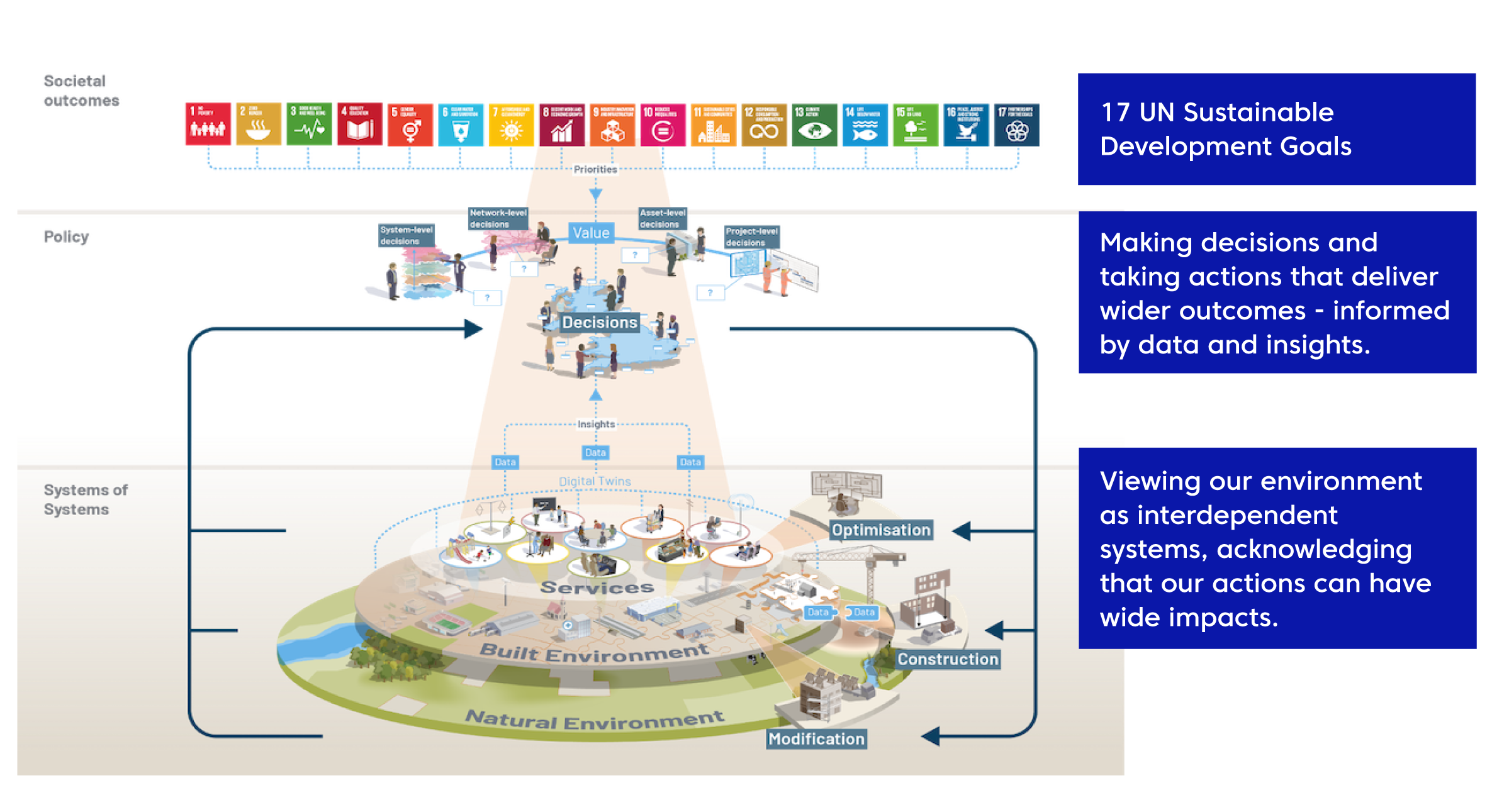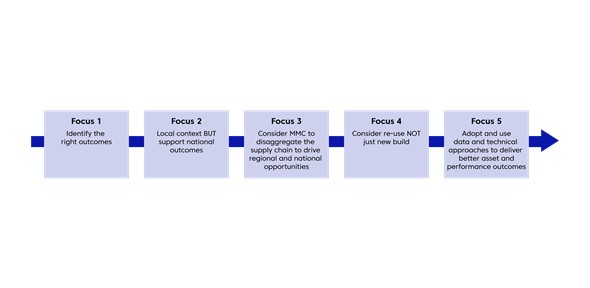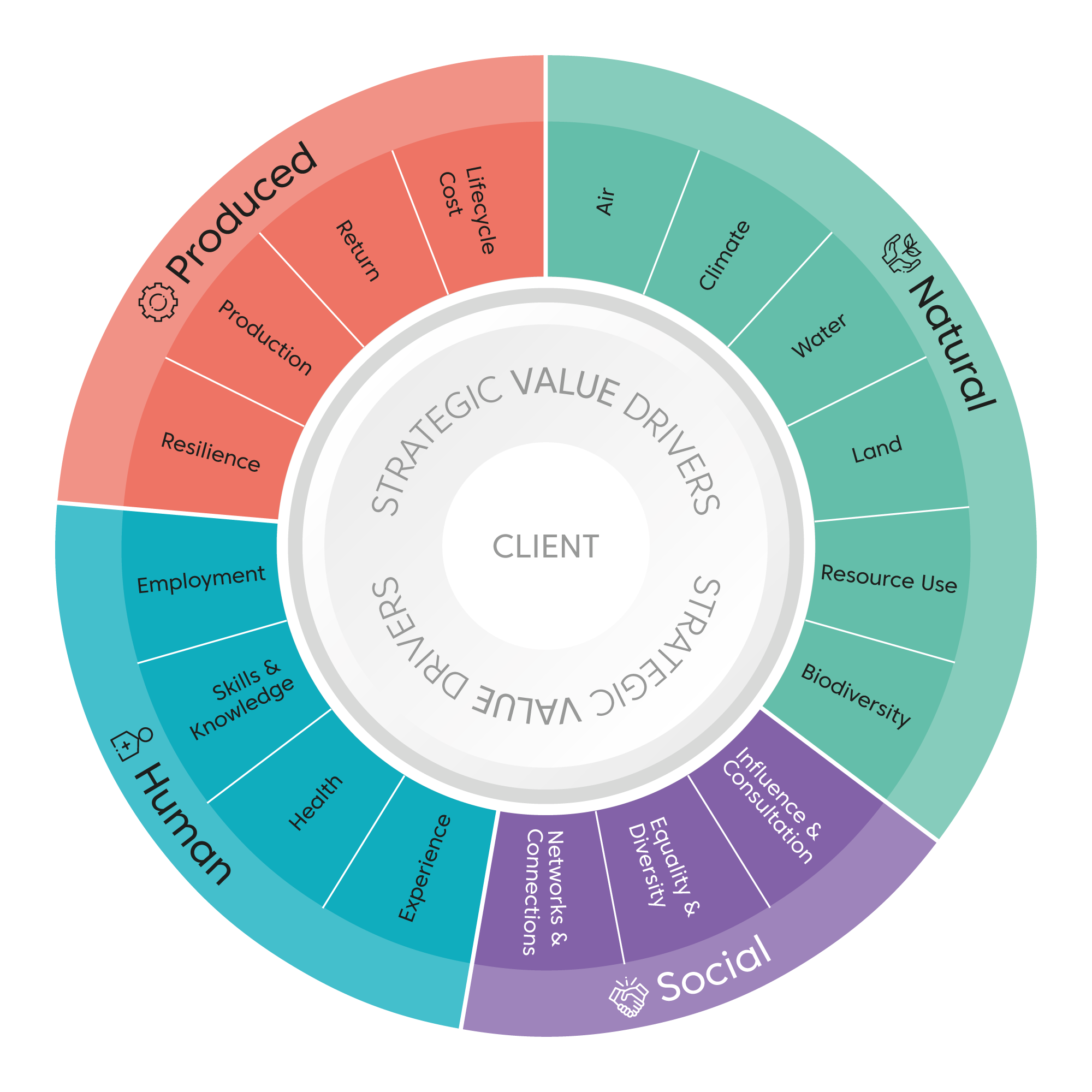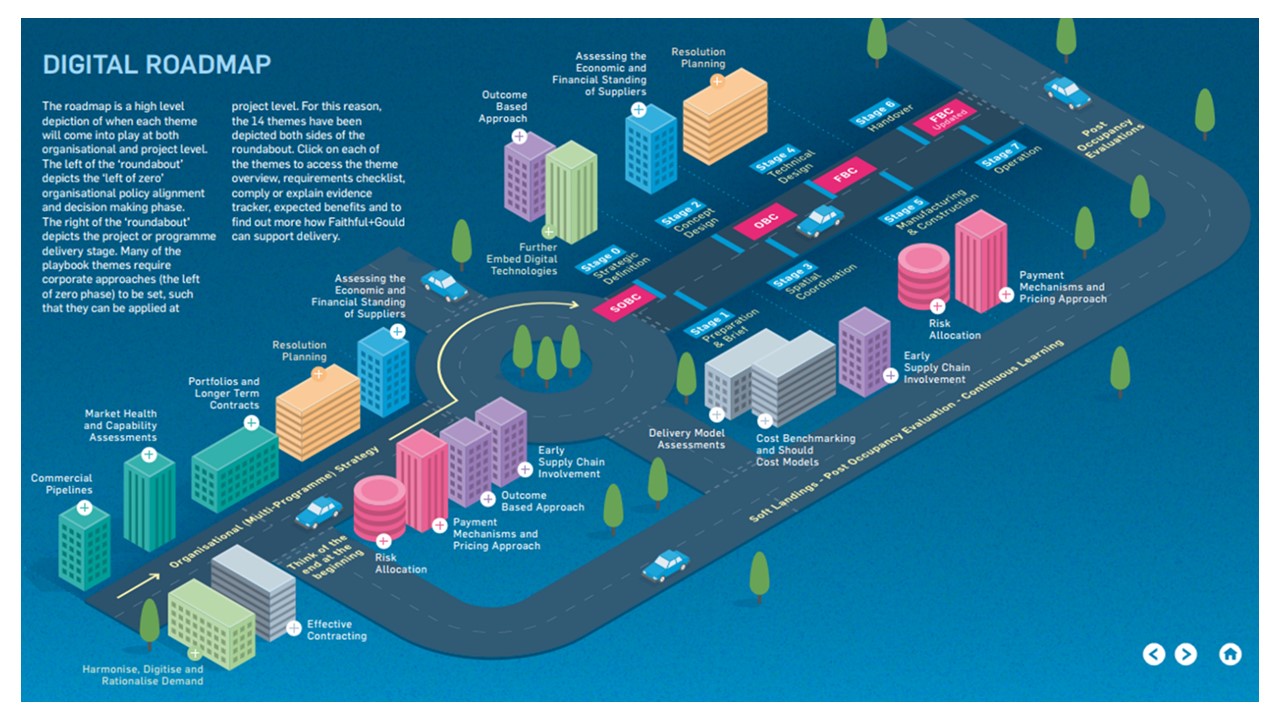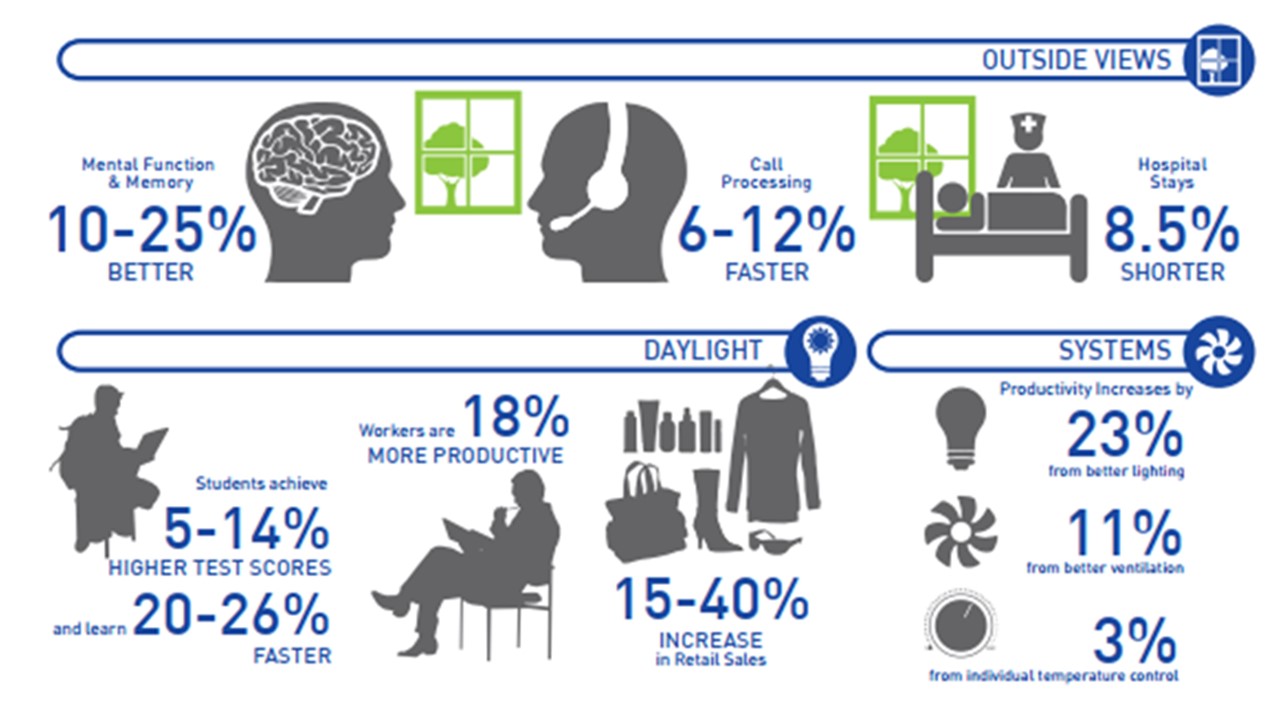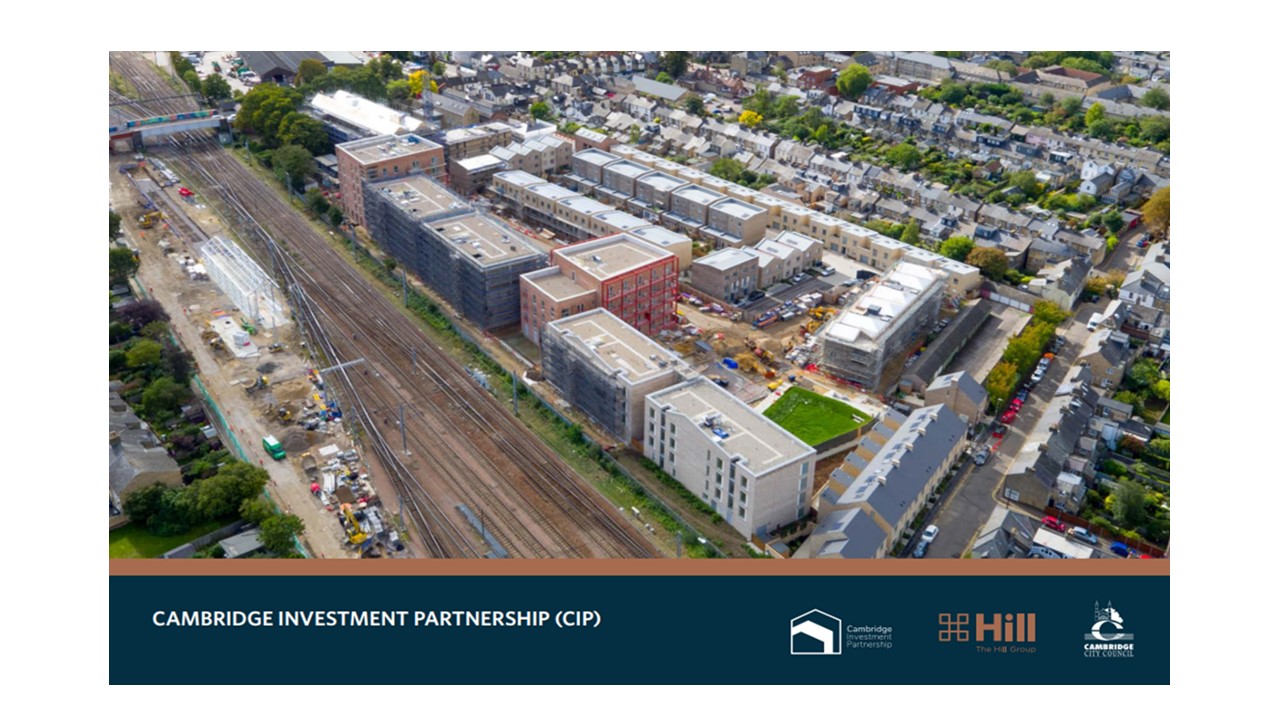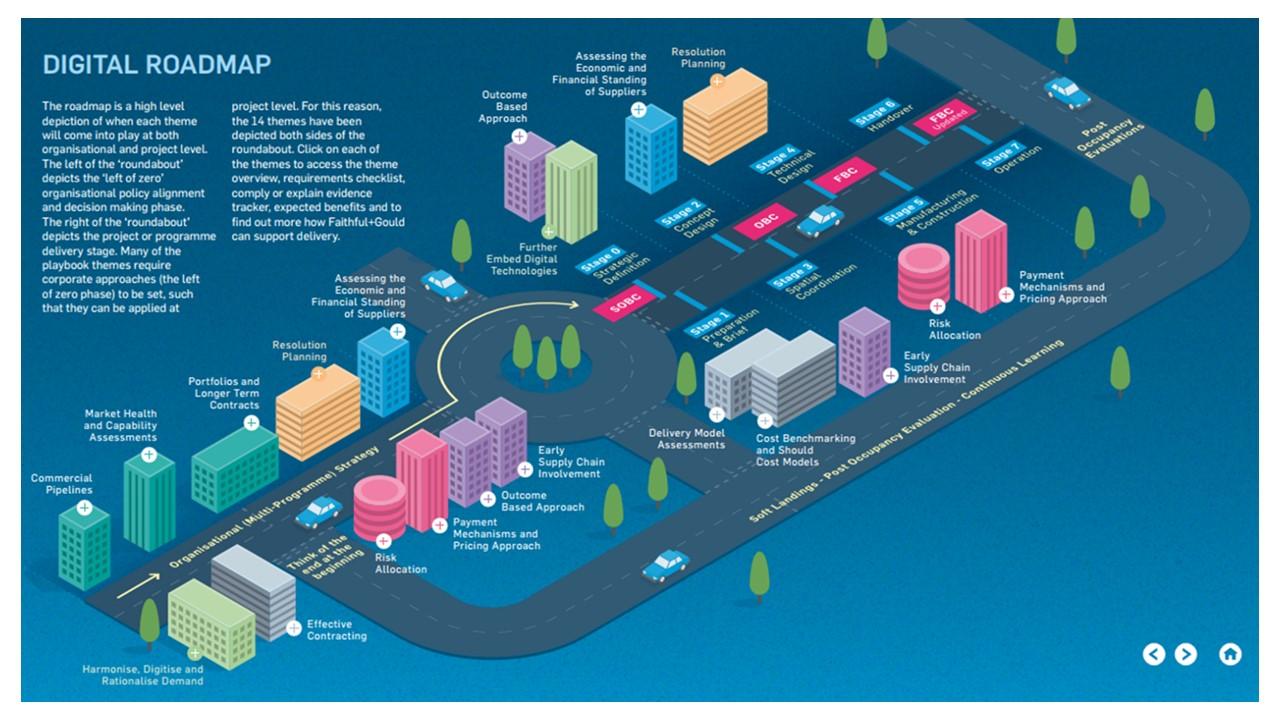
Submitted by Jo Daye on Thu, 10/02/2022 - 15:43
Impacts and benefits of incorporating the TIP Roadmap (2030), Construction Playbook and Value Toolkit for Local Authorities
Executive Summary
The UK Government has developed or supported three key documents and productivity initiatives that are covered in this paper. The Transforming Infrastructure Performance Roadmap to 2030 (TIP Roadmap), the Value Toolkit and the Construction Playbook.
These all set out to drive increased value from the assets delivered across the public sector. There are many pressures on public sector clients to deliver faster, better and greener, all against a hardening budgetary position and supplier market. The approaches should be viewed as a nested, complementary approach that aids effective delivery of programmes and projects whose briefs better articulate broader outcomes rather than an overriding focus on capital cost. They have the potential to deliver significant social value and capital cost efficiencies. They have a primary focus on central government departments, agencies and arm's length public bodies. However, their intent is relevant to all public sector procurers and should therefore be reviewed and understood by local authorities and applied to suit the organisation’s circumstances.
The documents are positioned not as a set of compliance rules, but as a framework to test an organisation’s current processes and to support conversations to identify if delivered outcomes and benefits can be wider than a simple time and cost metric.
Background
In the UK, local authorities (or local councils) are responsible for a range of vital services including social care, housing, waste collection and schools. The 343 councils in England were responsible for a collective spend of £25bn on capital expenditure (2017-18). This represents a 25% increase over a five-year period. Increasing budget pressures is a common challenge shared across local authorities and they must balance this with the responsibility for meeting key national policies, including carbon reduction, as well as a focus on service improvement and delivering the best quality of life for those who live in their area.
This paper introduces a range of recent policies and tools that drive and support central government departments and other organisations to plan and deliver projects in a way that delivers value measured beyond ‘time and cost’ and looks at how these could be applied in a local authority context and the benefits that this could bring to the sector.
(Reference data MHCLG LA Capital Exp Receipts England 2017-18 Final Outturn paper).
What are the core initiatives driving change?
- Transforming Infrastructure Performance Roadmap to 2030(TIP Roadmap)
- Construction Playbook
- Value Toolkit.
The Transforming Infrastructure Performance Roadmap to 2030 (TIP Roadmap) was published in September 2021. Nick Smallwood, Chief Executive Officer at the IPA, said, “The TIP Roadmap is the Infrastructure and Projects Authority’s (IPA) flagship programme and it aims to lead system change in the built environment. Its purpose is to transform how government and industry decide to intervene in the built environment, to drive a step change in infrastructure performance”.
At the time of its publication, Rt Hon Jesse Norman MP, the then Financial Secretary to Treasury, said,
“We want government departments and their delivery bodies to think robustly about how they are translating intended outcomes into delivery. We want our industry partners to bring forward innovative solutions that accelerate progress, to consistently deploy new technologies to improve project performance and to invest in the skills and training that will build our future workforce.”
The TIP Roadmap is broken into five key areas:
- Delivering new economic infrastructure to drive improved outcomes for people and nature
- Place based regeneration and delivery
- Addressing the need for social infrastructure using a platform approach
- Retrofitting existing buildings to achieve net zero greenhouse gas (GHG) emissions by 2050
- Optimising the performance of our existing built environment
TIP Roadmap key points
At a high level the TIP Roadmap looks at our environment as a system made up of different systems: the natural environment, built environment and the services that are delivered through them. A systems view is important, as to maximise our outcomes, we need to regard our environment as a collection of systems working together and not individual bits of infrastructure. It is also vitally important to recognise that people consume services and not infrastructure. Therefore, it’s the outcomes that will dictate success and not necessarily the outputs of a project.
Therefore, in short the five TIP Roadmap areas are trying to:
- Create national social equality
- Create diverse opportunity
- Support a robust supply chain environment
- Drive a manufacturing approach to construction delivery
- Deliver greater value than the committed capital
Diag 1: The TIP Roadmap, Infrastructure and Projects Authority
Diag 2: TIP Roadmap policy approachThe Value Toolkit
The Value Toolkit is a multi-stakeholder project led by the Construction Innovation Hub part of the Government's Transforming Construction Challenge. Its aim is to support delivery of the TIP Roadmap and the Construction Playbook, through a five step approach that helps to:
- Define value. This aligns with the social and system outcomes described in the TIP Roadmap. The toolkit uses a four capitals approach. This covers the themes of produced, natural, human and social capitals. Each capital is sub-divided to enable a focused value profile to be drafted. See diagram below.
- Risk definition. Supports a move from traditional risk off-loading to considered risk allocation.
- Client approach. Supports the client’s decision-making process to best align commercial and contracting practices, market engagement, how best to embed the project or programme value outcomes and how the project can be set up to optimise delivery and measure if the value outcomes have been met.
- Measurement and Evaluation. The output of this is the drafting of a value index. The value index will provide a list of measurable metrics to support option comparison and outcome measurement, well beyond the traditional time and cost.
- Appointments. The toolkit approach helps a client engage the right delivery team.
Diag 3: Value Definition Four Capitals - Value Toolkit, Construction Innovation Hub
The Construction Playbook
The Construction Playbook (CPB) provides a best practice approach to test the decision making and delivery process adopted by a client organisation. It provides a roadmap that supports the TIP and the Value Toolkit delivery.
It sets out in 14 key policies how the government should assess, procure and deliver public works projects and programmes which all central government departments and their arms length bodies are expected to follow on a ‘comply or explain’ basis. The approach provides an audit record of decision-making that will ensure public money is used to best effect.
- Commercial pipelines – sharing of upcoming work to invoke market interest and engagement.
- Market health and capability assessments. Can the market to respond to your requirements?
- Portfolio and longer term contracting. Can larger contracts or strategic partnerships drive investment and better outcomes?
- Harmonise, digitise and rationalise demand. This will accelerate the development and use of platform approaches.
- Further embed digital tools. Using Information Management (IM). Delivering on the TIP Roadmap IM Mandate.
- Early supply chain involvement. Can early engagement and or contracting with the supply chain deliver better and more consistent outcomes?
- Outcomes-based approach. This is very much a TIP Roadmap delivery. Can we deliver against the system rather than just a focus on the individual asset?
- Benchmarks and should cost models. Do clients hold good and relevant benchmark data to know how much something should cost in order to deliver on the value outcome stated? Can these be used to enable better selection of delivery partners?
- Delivery model assessments. Will what we have always done deliver the best outcomes? Assessing different approaches and their impacts on delivery of the defined values is key.
- Effective contracting. Is the chosen contract route able to create the right environment?
- Risk allocation. Does the risk allocation approach sit the risk with those best able to manage it? Does the risk approach align with the delivery of innovation and outcomes?
- Payment mechanisms approach and pricing. Is the approach to price assessment fair and does it reflect the market?
- Assessing the economic and financial standing of a supplier. Is your supply chain robust for the relationship required?
- Resolution planning. Hope for the best but plan for the worst. Can effective service provision be maintained if a supplier relationship fails?
The 14 policies support consideration and delivery of the TIP Roadmap and the Value Toolkit. They also support existing mandates and renewed mandates for information management and digital adoption. The policies should be reviewed at an organisational as well as a project level.
The diagram below sets out a roadmap for consideration. The left of the roundabout shows decisions to be made as organisational policy with the decisions to the right of the roadabout the corporate policies being deployed at project and programme level. It is important to create the continuum.
Diag 4: Digital Roadmap for local authorities
Why are these documents relevant to local authorities?
The documents are all focused on driving better decision-making that leads to better outcomes and better value. They should, therefore, be aligned to all public sectore procurement bodies as the issues they set out to resolve are very much those faced by the local authority sector.
- Creating and delivering social value.
- Delivering more sustainable infrastructure and better service delivery.
- Creating better places to live and work
Local authorities should be aware of these initiatives and assess if they are aligned to them and consider how they could be of benefit. Creating a delivery landscape that makes engagement with the supply chain clearer, easier and fairer can also help drive efficiencies alleviating budget challenges faced by the sector.
Developing a higher degree of collaboration, clarity and alignment within an organisation will help identify what is important, not just a referral to time, cost and quality. They are of course important, but it is how value is identified and measured that will drive delivery of local authority strategic outcomes and how they will be embedded throughout the delivery process.
These documents are principally aligned to central government departments, executive agencies and arm's length public bodies. It is therefore understandable that local authorities may view them as being more relevant to large scale procurements and high value programmes, larger than a local authority may consider they manage. However, they drive a coherent and collaborative approach to project and programme identification, procurement, delivery and handover that are as relevant to local authorities to get right as they are to any other delivery body. Local authorities are in some ways ahead of larger central government procurers in their pursuance of social value and net zero.
In common with other key initiatives such as the implementation of digital ways of working, the introduction of Information Management, the adoption of Building Information Modelling (BIM), the implementation of Soft Landings, the introduction of off-site manufacturing, these resources have all been developed to aid the delivery of better outcomes. However, they can be viewed as an all or nothing adoption, which is creating a barrier.
This paper is part of a series of papers and tools from the Local Authority Digital Working Group (LADWG) enabled by the Construction Innovation Hub. The approach of the LADWG is to promote a low risk approach to adoption. This and previous papers, acknowledge the current practices and constraints of local authorities and provide ways for organisations to adopt and evaluate new approaches that could drive better outcomes, but where current thinking is that they would be too disruptive or costly.
The premise of the Construction Playbook is ‘comply or explain’. This approach is helpful, enabling an organisation to review their practice and process against the 14 policy statements. An assessment promotes identification of gaps that could be constraining supply chain engagement and therefore competition and ultimately benefit delivery.
The Value Toolkit provides an approach that enables ‘true’ value to be identified. Project or programme scope can then be tested against the identified values and decisions made on outcome-based assessment, not cost alone. The suitability of an asset impacts the quality of service or activity delivered from it.
The diagram below is an extract from the ‘Business Case for Green Buildings’ as published by the World Green Building Council (2013.) The case is made that identifying true value and managing and measuring its delivery, will support the delivery of significant outcome benefits. Adopting the approaches as outlined above will best position an organisation’s ability to understand what is important to them, how they will articulate and measure it and test the suitability of their organisational approach to deliver it. Ensuring required outcomes are aligned with design intent, together deliver better results.
Diag 5: Business Case for Green Buildings, World Green Business Council
How can local authorities engage with these processes?
The documents are downloadable from the website links below.
Transforming Infrastructure Performance Roadmap to 2030 (TIP Roadmap)The TIP Roadmap sets the strategic approach and prompts consideration of social factors that could be addressed in programmes and projects.. It prompts thought on how, through a systems approach to planning, their delivery can impact more widely across delivery of the organisation’s key strategic aims such asnet zero, social mobility, addressing unemployment etc. The TIP Roadmap is interactive with links to material that support a wider understanding with tips and hints on how to embed in organisational thinking and planning.
Adoption of the TIP Roadmap is good practice. It does not require financial investment, but will, if used effectively, drive increased productivity and wider beneficial societal outcomes.
Value Toolkit
Understand and agree what added value can be delivered through the local authority’s capital investment. Through facilitated workshops with the authority’s staff and stakeholders that are relevant to a programme or project being considered, use the Value Toolkit approach to help identify what is important.
The Value Toolkit is currently being refinded by the Construction Innovation Hub based on technical feedback from pilot projects from a range of sectors including local authorities.
The Construction Playbook
The Construction Playbook is a good practice guide to help create the right environment for successful project delivery. It is structured into 14 clear policy steps. These should be used as a challenge to organisations to consider if implementation would help them deliver better projects, support a realisation that they are already complying or the policy as stated is not suitable but different approaches have been adopted that support the spirit of the policy.
The policy statements have an intent to not only drive better supply chain engagement but also a consideration for the adoption of digital ways of working and new modern methods of construction (MMC) approaches to asset delivery. An effective engagement mechanism for local authorities is to use the playbook policy list as a challenge to projects and to consider their impact and action required. Noting the organisations compliance, intended action or reason for non-incorporation.
Where a policy may seem more aligned to larger programmes of work, they should not necessarily be discarded by an authority. Can alignment with other authorities or organisations provide a platform for engagement and the ability to deliver better outcomes through a combined scale of requirement?
A case study from Cambridge City Council and their approach to housing delivery is included in annexe A below.
Links to documents
Transforming Infrastructure Programme – https://www.gov.uk/government/publications/transforming-infrastructure-performance-roadmap-to-2030
Value Toolkit – https://constructioninnovationhub.org.uk/value-toolkit/
Construction Playbook – https://www.gov.uk/government/publications/the-construction-playbook
Links to previous LADWG publications:
- BIM in local authorities - https://www.cdbb.cam.ac.uk/news/publication-bim-local-authorities
- BIM early steps roadmap and toolkit for local authorities - https://www.cdbb.cam.ac.uk/news/press-release-LA-Roadmap
- Applying Government Soft Landings and delivering the golden thread of data in a local authority context - https://www.cdbb.cam.ac.uk/news/applying-government-soft-landings-and-delivering-golden-thread-data-local-authority-context
This paper has been drafted by the LADWG membership, see below, enabled by the Construction Innovation Hub.
Terry Stocks – Chair of LADWG
Members of the Local Authorities (LA) Working Group
3C Shared Services - Building Control (Cambridge City, Huntingdonshire and South Cambridgeshire)
East Riding of Yorkshire Council
Northern Ireland Gov – Finance and Procurement
Stockport Metropolitan Borough Council
For more information about the local authority working group see www.cdbb.cam.ac.uk/localauthorities
******
ANNEXE A: Case Study
Cambridge City Council – Cambridge Investment Partnership
- The Cambridge Investment Partnership (CIP) was established in February 2017, to support Cambridge City Council in addressing its acute housing need by providing high-quality brand-new council homes and market sale homes, along with commercial and community facilities. As part of the £70m Cambridgeshire and Peterborough Devolution Grant, CIP committed to start on site to build 500 new council homes by March 2022.
- Cambridge City Council have taken a strategic look at their delivery requirements, they have developed a multiyear programme that has enabled intelligent and effective engagement with delivery partners which has enabled the CIP to be formed. They have worked as a member of the partnership ensuring the delivery supply chain is aware and capable to deliver against their stated outcomes. They have created a clear vision and statement of purpose for why they are pursuing their goals. Cambridge City Council and their CIP are a great example of how alignment with the central Government’s key capital programmes delivery can be embraced and deployed by a local authority.
- The establishment of the CIP, the development of outcome requirements, stakeholder engagement and partnership culture reflects many of the drivers and cultures as articulated in the Transforming Infrastructure Performance (TIP) programme, the Value Toolkit and the Construction Playbook.
- Cambridge City Council has developed requirements that reflect the TIP ‘systems of system’ approach. The houses delivered and planned provide positive impacts on the natural environment creating a built environment that benefits those who live and work around and within the developments. The developments provide affordable housing which delivers against core social value outcomes. There has been an approach to standardisation which again delivers against the TIP and the Construction Playbook drive for increased use of offsite manufacturing. As promoted by the Value Toolkit the partnership is founded on clear value outcomes and is held to account against their delivery. Cambridge City Council’s approach to testing the market to ensure their chosen partner aligns to their values, to align risk between the parties and create management mechanisms that ensure all those party to the partnership are represented and have a voice to steer outcomes to maximise delivered benefits, are great examples of the Construction Playbook policies being implemented in a local authority setting.
- The following Cambridge Investment Partnership overview provides more detail on how this has been achieved.

